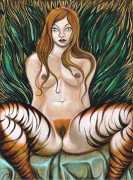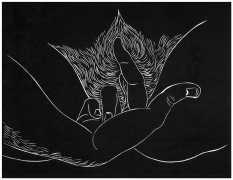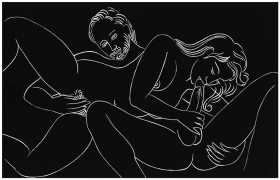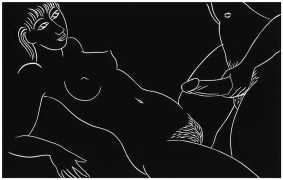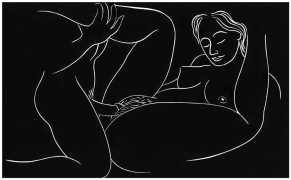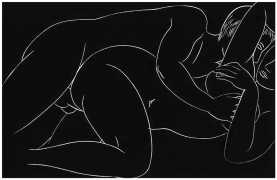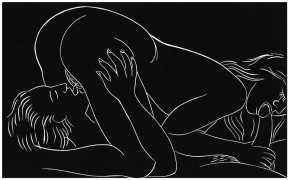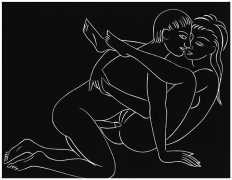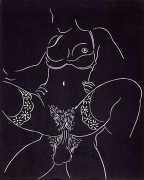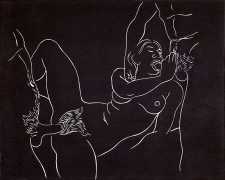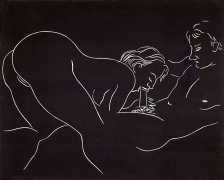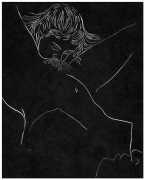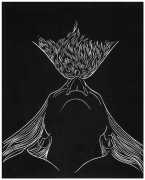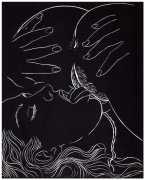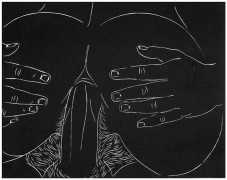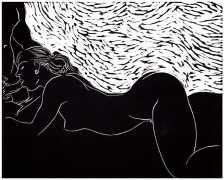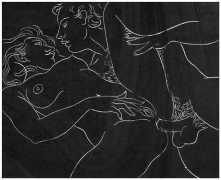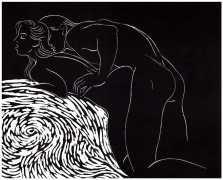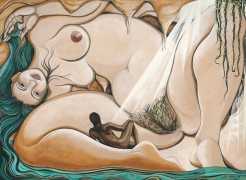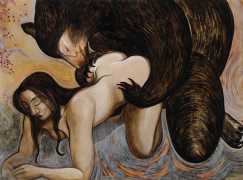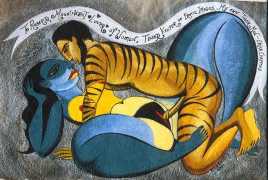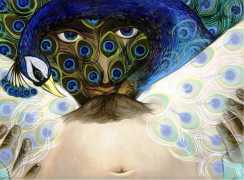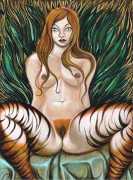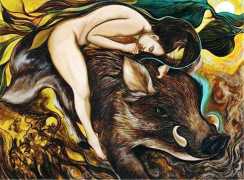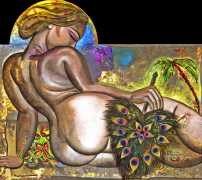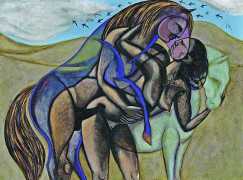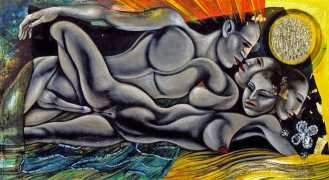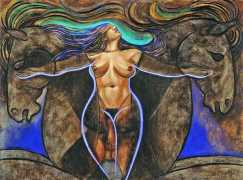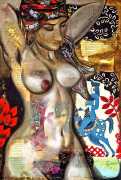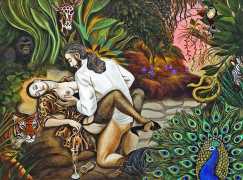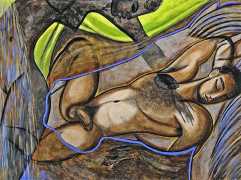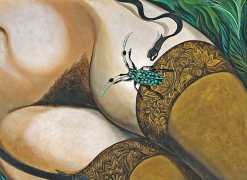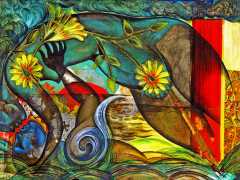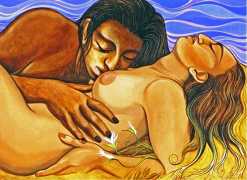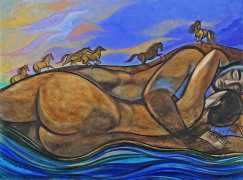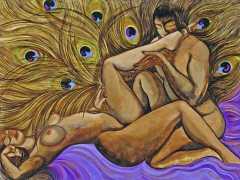 The Detroit-based American artist Erica Chappuis grew up Washington DC, where from the age of thirteen she began taking summer courses at the Corcoran School of Art and studying with independent Washington area artists. In high school she was selected for an experimental course in portraiture at the National Portrait Gallery of the Smithsonian Institution, the first of its kind. She graduated from Carnegie-Mellon University in Pittsburgh with a Bachelor of Fine Arts. She has strong links with Europe, both with England where her forebears hail from, and with Switzerland through her husband Laurent.
The Detroit-based American artist Erica Chappuis grew up Washington DC, where from the age of thirteen she began taking summer courses at the Corcoran School of Art and studying with independent Washington area artists. In high school she was selected for an experimental course in portraiture at the National Portrait Gallery of the Smithsonian Institution, the first of its kind. She graduated from Carnegie-Mellon University in Pittsburgh with a Bachelor of Fine Arts. She has strong links with Europe, both with England where her forebears hail from, and with Switzerland through her husband Laurent.
Erica set up her studio in Detroit in 1982, and has been a practicing artist ever since, specialising in figurative subjects. During the 1990s much of her work included more or less erotic themes, bold paintings exploring the relationship between the sensual connections between human bodies and nature, and black and white etchings of more explicitly sexual couplings. It is these themes we feature here, though we recommend a visit to Erica’s website, where similar powerful themes of the sea and voyaging are expanded. Her erotic work is included in the collections of the Erotic Art Museum in Barcelona and the Kinsey Institute at Indiana University.
In January 2019 the art blogger Janet Kozachek interviewed Erica Chappuis, and asked some pertinent questions, including issues of censorship and the male gaze. We have included some of that interview below; if you are interested you can read the whole piece here.
The Art of Erica Chappuis: An Exotic New Wave
According to the American Civil Liberties Union, nudity or sexual content is the most frequently cited reason for censorship in art. Some of your work is unabashedly erotic. Has that been problematic in having your work publicly exhibited? Have you ever had to pull work from an exhibition?
Censorship is a fact of life these days and always has been. I had a perfectly classical nude rejected by a Japanese print show many years ago, and I have had tasteful nudes displayed in gallery windows receive complaints from neighbors (who always express concern for school children walking past) and the gallery owners finding it necessary to cover up said nude. I had a nude angel rejected by a church art show. I haven’t had much issue with the very explicitly erotic work since I exhibit it in venues where they are only visible to people who directly wish to see them. Clearly I wouldn’t be submitting explicit work to a church show, or allow it to be displayed in a gallery window. But although I am not currently producing explicitly erotic work, my mermaids are nude and my bar girls are often a little risqué. In most places that has not been an issue but it wouldn’t come as a great surprise if it were.
How might a woman artist’s perspective broaden understanding about the nature of human interaction, especially between genders?
I’m not entirely certain most women artists can offer much of a difference in the nature of human interaction, mainly because a painting is not a play. It is limited in what it can show without a time-based part of the work – such as would exist in a play, video or performance. If a woman artist is working in those media, then she has a better chance of expressing such ideas. If a painter or sculptor, working in more traditional ways were to attempt it, it might come off as poster or propaganda work. I think some ideas are better expressed via a play, novel, poem or new art media with time based aspects. The best I can do in my painting, so far, is to depict men and women in roles that are the opposite to how they traditionally would have been seen, or else produce something that might feel like propaganda. Also I believe women have inherited a great deal of how men view the world and it takes a different medium to see it differently.
You frequently depict images of women in your work. In contemporary art criticism, much has been made about the ‘male gaze’ in art and cinema. In what ways might images of women created by other women change that gaze? And it what ways might it not?
I think women see via ‘male gaze’ every bit as much as men do. We have inherited all of art history and so its limitations are ours as well. Also, a lot of women, especially young women, revel a bit in the male gaze. John Berger says that men look at women and women look at themselves being looked at. I think this is profoundly true. I see young women enjoying their sexual expression and the effect they have on men. I think they know how to ‘stage’ themselves and enjoy doing it. I don’t see my work as much different in its erotic nature from that. ‘I know what boys like’ every bit as much and stage my paintings to express at least some of that. And do girls like anything all that different? I’m not so sure they do!
How does an artist then change the way, say, a woman is viewed in an artwork, and thereby broaden viewers’ perspectives?
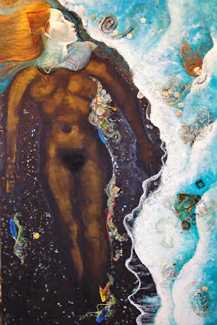
The only way I have been able to find for myself a way to change the gender of the viewer in my paintings is to change the gender of the subject, and even that is no guarantee that I’m getting away from the ‘male gaze’, because my male Siren is going to appeal to some men. In fact, my female Sirens may appeal to women more than men. Women do look at other women and enjoy looking at female bodies as depicted in art. We have adopted the ‘male gaze’ and use it, both for our enjoyment and for the manipulation of social situations. It has never changed and I doubt it ever will. It has been around since the cave paintings of Lascaux – paintings that may well have been made by women as well as men for all we know.
What about how women, especially women artists, might fix their gaze upon themselves?
I see how some women artists equate the earth with their own bodies, some who create works with earth and other natural elements, and others who work using photographs or video with a ‘Goddess’ attitude or philosophy behind it. Although many of those works are very beautiful and often poignant, I’m not sure that they are very different in kind than a female (or male) nude ‘served up’ erotically to the viewer. They are still women looking at women – which apparently women prefer to looking at men from all the studies I’ve ever seen. This is an appreciation for everything that a woman’s body contains –symbolism, magic, creation and eroticism.
Erica Chappuis’s website, where you can see more of her work, mostly themed around the sea, ships and sirens, can be found here.

